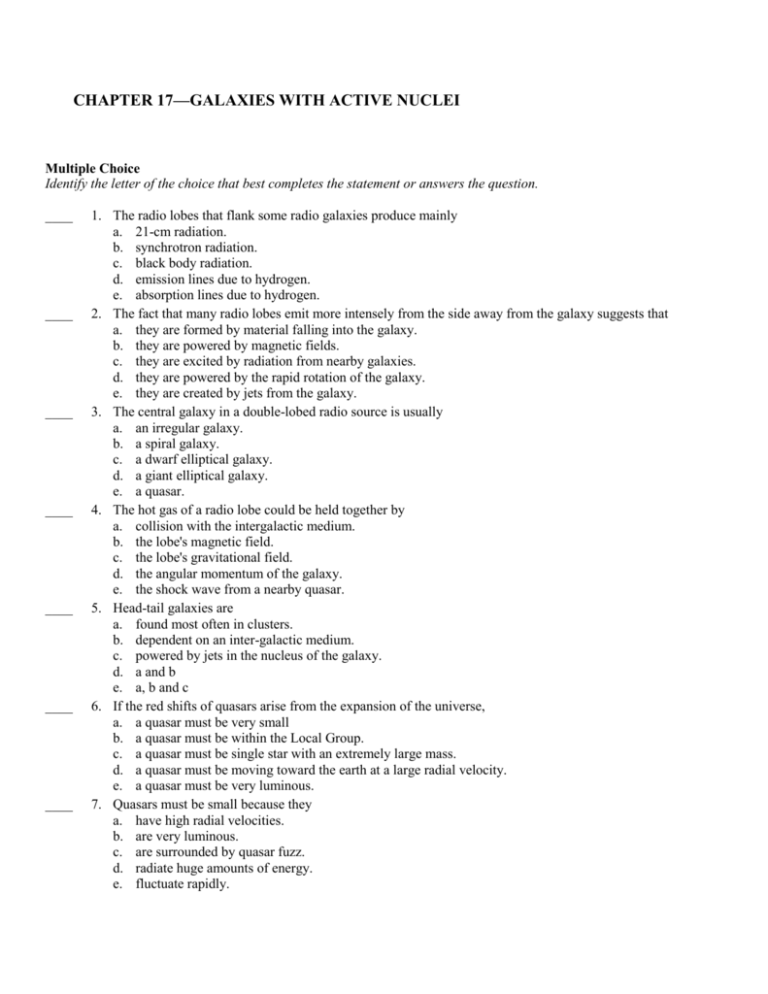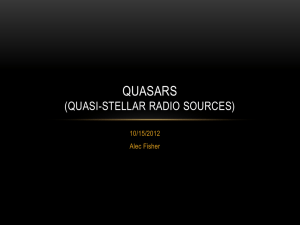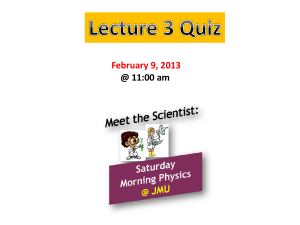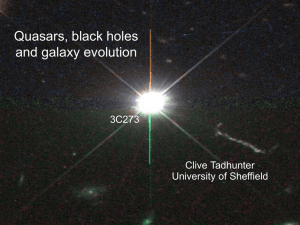CHP 17
advertisement

CHAPTER 17—GALAXIES WITH ACTIVE NUCLEI Multiple Choice Identify the letter of the choice that best completes the statement or answers the question. ____ ____ ____ ____ ____ ____ ____ 1. The radio lobes that flank some radio galaxies produce mainly a. 21-cm radiation. b. synchrotron radiation. c. black body radiation. d. emission lines due to hydrogen. e. absorption lines due to hydrogen. 2. The fact that many radio lobes emit more intensely from the side away from the galaxy suggests that a. they are formed by material falling into the galaxy. b. they are powered by magnetic fields. c. they are excited by radiation from nearby galaxies. d. they are powered by the rapid rotation of the galaxy. e. they are created by jets from the galaxy. 3. The central galaxy in a double-lobed radio source is usually a. an irregular galaxy. b. a spiral galaxy. c. a dwarf elliptical galaxy. d. a giant elliptical galaxy. e. a quasar. 4. The hot gas of a radio lobe could be held together by a. collision with the intergalactic medium. b. the lobe's magnetic field. c. the lobe's gravitational field. d. the angular momentum of the galaxy. e. the shock wave from a nearby quasar. 5. Head-tail galaxies are a. found most often in clusters. b. dependent on an inter-galactic medium. c. powered by jets in the nucleus of the galaxy. d. a and b e. a, b and c 6. If the red shifts of quasars arise from the expansion of the universe, a. a quasar must be very small b. a quasar must be within the Local Group. c. a quasar must be single star with an extremely large mass. d. a quasar must be moving toward the earth at a large radial velocity. e. a quasar must be very luminous. 7. Quasars must be small because they a. have high radial velocities. b. are very luminous. c. are surrounded by quasar fuzz. d. radiate huge amounts of energy. e. fluctuate rapidly. ____ ____ ____ ____ ____ ____ ____ ____ 8. We suspect that quasars are the active centers of galaxies because a. quasar fuzz produces stellar spectra. b. a few quasars have large red shifts. c. some quasars fluctuate rapidly. d. all of the above. e. none of the above 9. Superluminal expansion can be explained if a. supernova blast waves can go faster than light. b. quasars are at cosmological distances. c. quasars spin fast and have strong magnetic fields. d. quasars eject beams of radiation. e. quasars are located within our galaxy. 10. The discovery of the gravitational lens effect for the double quasar QSO 0957+561, confirmed a. that quasars were located within the local group of galaxies. b. that quasars were giant elliptical galaxies at very great distances. c. Einstein's theory of general relativity that had predicted that large masses could bend light. d. Newton's theory of universal gravitation by showing that the photon was affected by gravity. e. the existence of super massive black holes at the center of active galactic nuclei 11. _______________ occurs when material is ejected from a quasar that appears to be moving faster than the speed of light. a. Superluminal expansion b. A blazar c. A gravitational lens d. A Type 1 Seyfert galaxy e. A head-tail galaxy 12. The local hypothesis states that a. active galactic nuclei are produced by the merger of galaxies. b. blazars are produced when material is ejected along the poles of a super massive black hole. c. quasars are produced when two galaxies merge to form a super massive black hole. d. the center of the Milky Way and Andromeda galaxies contain super massive black holes. e. quasars' red shifts are not due to the cosmological expansion of the universe. 13. The hot spots in the double-lobed radio galaxies are a. produced by nuclear fusion of hydrogen. b. produced by the interaction of high speed particles from the jets with the intergalactic medium. c. found in the portion of the lobes that are closest to the galaxy producing the lobes. d. produced by a gravitational lens of a single quasar. e. produced by the accretion disk around a super massive black hole. 14. A(n) _______________ is observed if our line of sight is parallel to the plane of the dense disk of an active galactic nucleus. a. blazar b. Type 1 Seyfert c. Type 2 Seyfert d. superluminal expansion e. quasar 15. A BL Lac object is the same as a(n) a. Type 1 Seyfert. ____ 16. ____ 17. ____ 18. ____ 19. ____ 20. ____ 21. ____ 22. b. Type 2 Seyfert. c. double-lobed radio galaxy. d. blazar. e. quasar. _______________ is (are) observed when light from a distant quasar travels past a massive galaxy between the quasar and us. The massive galaxy focuses the light to form two or more images of the same quasar. a. A double-lobed radio galaxy b. Superluminal expansion c. The gravitational lens effect d. A blazar e. Gravitational waves _______________ show(s) that some quasars are further away than distant galaxies, and that space-time is curved by massive objects. a. Double-lobed radio galaxies b. Blazars c. The gravitational lens effect d. Head-tail galaxies e. Superluminal expansion Seyfert galaxies a. are more common in close pairs of galaxies than in isolated systems. b. emit more energy at x-ray, ultraviolet, infrared, or radio wavelengths than normal spiral galaxies. c. generally show red shifts greater than 1. d. a and b e. a, b and c Many quasars contain narrow absorption lines in addition to the red shifted emission lines. The narrow absorption lines do not have the same red shift as the emission lines, and often, the red shifts of the narrow absorption lines will be different from each other. What is the most likely cause of the narrow absorption lines in quasar spectra? a. Material in the quasar that is expanding away from the central core of the quasar. b. Low density hydrogen clouds between galaxies and gas in galaxies between us and the quasar. c. Hydrogen gas in the broad line region of the unified model. d. Hydrogen gas in the narrow line region of the unified model. e. Superluminal material flowing directly away from the quasar, but toward us. In the unified model of active galactic nuclei, the broad line region in an active galactic nucleus is a. composed of clouds of gas and stars moving at very high orbital velocities. b. composed of a super massive black hole. c. responsible for producing the bright continuous radiation observed in blazars. d. responsible for the narrow absorption lines seen in Type 2 Seyfert galaxies. e. located further from the core than the narrow line emission region. The unified model describes active galactic nuclei using a. a super massive black hole at the center of a normal spiral galaxy. b. a super massive black hole surrounded by an accretion disk and a dense disk of gas. c. an accretion disk around a neutron star. d. gravitational lenses to intensify the radiation coming from them. e. different lines of sight toward a dwarf irregular galaxy. If Hubble's constant is taken to be 70 km/sec/Mpc, and a quasar is found with a radial velocity of 0.95 times the speed of light, how far away is the quasar? a. 4100 Mpc b. 0.014 Mpc c. 67 Mpc d. 74 Mpc e. 300,000 Mpc ____ 23. The hydrogen Balmer line H has a wavelength of 486.1 nm in the laboratory. It is observed in a quasar at 2430.5 nm. What is the red shift of this quasar? a. 5 b. 0.5 c. 0.25 d. 4 e. 1944.4 ____ 24. If a quasar has a red shift of 1, then its radial velocity is a. 100,000 km/sec. b. 112,000 km/sec. c. 180,000 km/sec. d. 300,000 km/sec. e. 0.6 km/sec ____ 25. The hydrogen Balmer line H has a wavelength of 486.1 nm in the laboratory. It is observed in a quasar at 972.2 nm. What is the radial velocity of this quasar? a. 2.4 105 km/sec b. 1.8 105 km/sec c. 6 105 km/sec d. 2 e. 1 True/False Indicate whether the sentence or statement is true or false. ____ 26. The Milky Way galaxy is not a radio galaxy; it emits no radio radiation. ____ 27. Double-lobed radio galaxies appear to be emitting jets of gas and radiation. ____ 28. The radio radiation emitted by a radio lobe is mainly synchrotron radiation. ____ 29. Seyfert galaxies are spiral galaxies with active cores. ____ 30. Head-tail galaxies are pairs of galaxies interacting with each other. ____ 31. Radio lobes are held together by their magnetic fields. ____ 32. The rapid fluctuations of quasars show that the objects must be very small. ____ 33. Quasar red shifts are usually larger than the red shifts of the visible galaxies. ____ 34. If a quasar has a red shift of 0.98, then it is receding from the earth at 98 percent the speed of light. ____ 35. Some quasars have fuzz around them that produces spectra like that of normal galaxies. CHAPTER 17 Answer Section MULTIPLE CHOICE 1. 2. 3. 4. 5. 6. 7. 8. 9. 10. 11. 12. 13. 14. 15. 16. 17. 18. 19. 20. 21. 22. 23. 24. 25. ANS: ANS: ANS: ANS: ANS: ANS: ANS: ANS: ANS: ANS: ANS: ANS: ANS: ANS: ANS: ANS: ANS: ANS: ANS: ANS: ANS: ANS: ANS: ANS: ANS: B E D A E E E A D C A E B C D C C D B A B A D C B TRUE/FALSE 26. 27. 28. 29. 30. 31. 32. 33. 34. 35. ANS: ANS: ANS: ANS: ANS: ANS: ANS: ANS: ANS: ANS: F T T T F F T T F T









